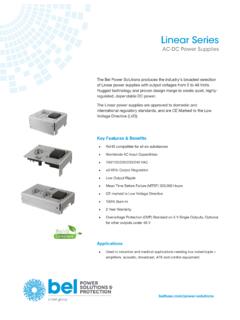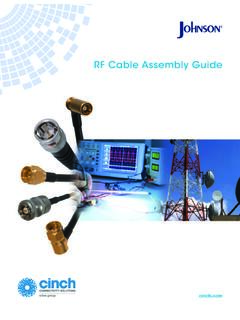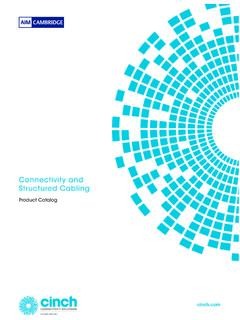Transcription of Surface Mount PTC - Bel Fuse
1 Surface Mount PTC. 0 ZCJ Series 0 ZCJ Series 1206 Chip RoHS 2 Compliant Product Features - 1206 Chip Size, Fast Trip Time, Low DCR Resistance - AEC-Q Compliant - Meets Bel automotive qualification*. * - Largely based on internal AEC-Q test plan Operating (Hold Current) Range 50mA - 2A. Maximum Voltage 6 - 60V (per table). Temperature Range -40 C to 85 C. Agency Approval TUV (Std. EN/IEC 60738-1-1 and EN/IEC 60730-1, Cert. R50102117). UL Recognized Component (Std. UL1434, File E305051). LEAD free =. AEC-Q Compliant HALOGEN free =. Electrical Characteristics (23 ). Hold Trip Rated Maximum Typical Max Time to Trip Resistance Tolerance Agency Approvals Part Number Current Current Voltage Current Power Current Time Rmin R1max IH, A IT, A Vmax, Vdc Imax, A Pd, W A Sec Ohms Ohms Z 0 ZCJ0005FF2E 60 10 Y Y.
2 A 0 ZCJ0010FF2E 60 10 Y Y. B 0 ZCJ0012FF2E 48 10 Y Y. C 0 ZCJ0016FF2E 48 10 Y Y. D 0 ZCJ0020FF2E 30 10 Y Y. 0 ZCJ0025FF2E 16 100 Y Y. E. 0 ZCJ0025AF2E 24 40 Y Y. 0 ZCJ0035FF2G 16 40 Y Y. F. 0 ZCJ0035AF2E 30 40 Y Y. 0 ZCJ0050FF2G 8 100 Y Y. G. 0 ZCJ0050AF2E 24 100 Y Y. 0 ZCJ0075FF2E 8 100 Y Y. H. 0 ZCJ0075AF2E 16 100 Y Y. I 0 ZCJ0100FF2E 6 100 Y Y. 0 ZCJ0110FF2E 8 100 Y Y. J. New Rating 0 ZCJ0110AF2C 16 100 Y Y. K 0 ZCJ0150FF2C 8 100 Y Y. L 0 ZCJ0200FF2C 6 100 Y Y. IH Hold Current- The maximum current at which the device will not trip in still air at 23 C. IT Trip current- The minimum current at which the device will trip in still air at 23 C.
3 Vmax Maximum voltage device can withstand at its rated current without suffering damage. Imax Maximum fault current device can withstand at rated voltage (Vmax) without damage. Pd Typical power dissipated by device when in tripped state in 23 C still air environment. Rmin Minimum device resistance at 23 C in initial un-soldered state. R1max Maximum device resistance at 23 C, 1 hour after initial device trip, or after being soldered to PCB in end application. Specifications subject to change without notice Type 0 ZCJ Series 2/4. PTC's Basic Theory of Operation / Tripped Resistance Explanation A Bel PTC consists of a block of polymeric material containing conductive carbon granules which is sandwiched between two conductive metal plates.
4 When this polymer block reaches approximately 125C, either due to current passing through it via conductive chains of carbon particles or due to an external heat source; it swells volumetrically. This expansion breaks apart a majority of the chains of carbon granules that run randomly between the two conductive plates. This behavior results in a sharp increase in resistance across the two plates which all but eliminates current flow through the device, allowing just enough residual current flow to maintain the block's internal temperature at 125C. Once this tripped state current is cut off, the polymer brick cools and shrinks to its original size, thereby allowing its broken carbon chains to reestablish themselves and permit the part to return to its low resistance state.
5 Once cooled to room ambient, the PTC will once again exhibit a resistance less than its R1max rating. At currents below the device IHOLD rating, AND at temperatures below 100C, the PTC maintains a resistance value below its R1 MAX rating. The catalog data for each device specifies a "Typical Power" value. This is the power required to exactly match the heat lost by the tripped device to its ambient surroundings at 23C. By Ohm's Law, power can be stated as: W = E /R. Thus the approximate resistance of a Tripped PTC can be determined by: R = E /W, where "E" is the voltage appearing across the PTC (usually the supply's open circuit voltage), and "W" is the Typical Power value for the particular PTC.
6 Since the PPTC acts to maintain a constant internal temperature, its apparent resistance will change based upon applied voltage and, to a lesser degree, ambient conditions. Consider the following A PTC with a Typical Power of 1 watt protecting a circuit using a 60V supply will demonstrate an apparent, tripped resistance "R" of: R = 60 /1 = 3,600 ohms This same tripped device when used to protect a 12V circuit would now present an apparent resistance of: R = 12 /1 = 144 ohms The value for Typical Power is "typical" because any physical factors that affect heat loss (such as ambient temperature or air convection) will somewhat alter the level of power that the PTC needs to maintain its internal temperature.
7 In short, PTCs do not exhibit a constant, quantifiable tripped resistance value. Average Time Current Characteristic Curve at 23 C. The Average Time Current Characteristic Curve and Temperature Rerating Curve are affected by a number of variables and these curves are provided for guidance only. Specifications subject to change without notice Bel Fuse Inc. +1 206 Van Vorst Street Jersey City, NJ 07302 USA 2019 Bel Fuse, Inc. Rev. 0 ZCJ Sep2019. Type 0 ZCJ Series 3/4..Pad Layout Termination Pad Materials The dimensions in the table below provide the recommended Matte Tin Plated Copper pad layout.
8 P S W. Nominal Nominal Nominal mm Inch mm Inch mm Inch All dimensions in mm. Mechanical Dimensions and Marking Dimensions Marking Code Part Number C D. Min Max Min Max b , IH code 0 ZCJ0005FF2E C. 0 ZCJ0010FF2E D. 0 ZCJ0012FF2E Y. 0 ZCJ0016FF2E Z. 0 ZCJ0020FF2E F. 0 ZCJ0025FF2E G. 0 ZCJ0025AF2E g 0 ZCJ0035FF2G J. 0 ZCJ0035AF2E j 0 ZCJ0050FF2G M. 0 ZCJ0050AF2E m 0 ZCJ0075FF2E P. 0 ZCJ0075AF2E p 0 ZCJ0100FF2E 1. 0 ZCJ0110FF2E R. 0 ZCJ0110AF2C r 0 ZCJ0150FF2C S. Temperature Derating Table 0 ZCJ0200FF2C 2. Temperature Derating I Hold Value -40 -20 0 23 30 40 50 60 70 85. 0005 and 0010 152% 136% 120% 100% 92% 81% 71% 60% 48% 30%.
9 0020 thru 0200 145% 131% 116% 100% 94% 86% 77% 69% 60% 48%. Thermal Derating Curve Cautionary Notes 1. Operation beyond the specified maximum ratings or improper use may result in damage and possible electrical arcing and/or flame. Temperature Derating Curve 2. These Polymer PTC (PPTC) devices are intended for protection 180% against occasional overcurrent/overtemperature fault conditions and may not be suitable for use in applications where repeated Percent of Hold and Trip Current 160% and/or prolonged fault conditions are anticipated. 140% 3. Avoid contact of PTC device with chemical solvent.
10 Prolonged contact may adversely impact the PTC performance. 120%. 4. These PTC devices may not be suitable for use in circuits with a 100% large inductance, as the PTC trip can generate circuit voltage 80% spikes above the PTC rated voltage. 5. These devices may be used in both DC and AC circuits provided 60% that peak-to-peak line voltage when carrying AC does not exceed 40% the PTC's Vmax rating. As PTCs are essentially thermal devices, the RMS value of AC current carried by a PTC will produce 20% tripping parameters and times-to-trip similar to those of a DC. 0% voltage of the same magnitude.







